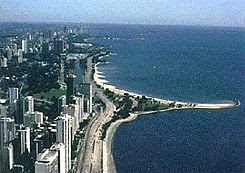 |
| A Cuspate foreland, solidified by vegetation |
- Cuspate forelands showing a wide range of form and occurrence have been described on accretion coasts from many parts of the world (Davies 1972; King 1972).
- Cuspate foreland is thought to form where a long-term balance, or near balance, exists between two or more opposing, but constructional, coastal forces. These forces may be either alongshore currents-drift-aligned features (Zenkovich 1959, 1967).
- Cuspate forelands,known as ;
Cuspate barriers
Nesses
- Geographical features found on coastlines & lakeshores.
- Created primarily by long shore drift.
 |
| Point Pelee cuspate foreland location |
- Formed by accretion and pro-gradation of sand & shingle.
- They extend outwards from the shoreline in a triangular shape.
- Some Cuspate forelands estabilised by vegetation.
- Others may migrate down the shoreline.
- Some cuspate forelands provide an important habitat for many flora and fauna.
- Where longshore drift occurs in opposite directions, two spits merge into a triangular protrusion along a coastline/ lakeshore.
- Their formation dependent on dominant & prevailing winds.
- Formation can also occur when waves are diffracted around a barrier.
- Cuspate forelands form coastlines & along lakeshores.

.jpg)


No comments:
Post a Comment